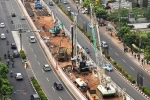New maritime highway route: Connecting the veins of island logistics
This article has been translated by PwC Indonesia as part of our Indonesia Infrastructure News Service. PwC Indonesia has not checked the accuracy of, and accepts no responsibility for the content.
Bisnis Indonesia - Rute baru tol laut: Menyambung urat nadi logistik kepulauan
12 October 2023
By: Peni Widarti
Maritime transportation plays a central role in increasing inter-island trade, especially in eastern Indonesia. The launch of the Surabaya-Kupang maritime highway route is expected to be the answer that accelerates the distribution of goods and services to maintain prices in both regions.
Recently, the shipping company PT Meratus Line started to operate the H6 maritime highway route that serves the Surabaya-Kupang-Surabaya route with a minimum cargo target of 55 containers.
Meratus Line President Director Slamet Raharjo said that the H6 route was the third maritime highway route for Meratus.
The company is also operating maritime highway ships on the H3 route (Jakarta-Padang-Jakarta), the T20 route (Surabaya-Tarakan-Surabaya), and the T33 route (Surabaya-Angrek-Surabaya).
“We hope that each ship can carry at least 55 containers so that the operation and the government’s programme can be optimum,” he said after launching the Hub & Spoke NTT Route Maritime Highway Container Loading programme at the dock of PT Berlian Jasa Terminal Indonesia (BJTI) in Surabaya on Wednesday (11/10).
He explained that, as a part of the maritime highway programme, Meratus would play an important role in the hub and spoke operational model through a cooperation with PT Pelayaran Nasional Indonesia (Pelni).
Regarding this matter, the motor vessel (KM) Meratus Kalabahi will carry a high load of cargo using a large container ship from the main port in Surabaya in East Java to Kupang in East Nusa Tenggara (NTT) and back to Surabaya.
Next, PT Pelni will also be responsible for the distribution of cargo to pioneer ports in regions, such as Sabu, Rote, Wini, Atapupu, Calabai, Larantuka, Lembata, and Kalabahi.
“The operational model is expected to distribute logistics goods faster and more evenly. It is also expected to reduce the prices of basic necessities,” he said.
Meanwhile, PT Pelni (Persero) Cargo Transportation and Maritime Highway Business Director Yossianis Marciano explained that the cooperation with Meratus was established due to the government’s assignment to reduce the disparity of prices in outermost, frontier, remote, and border (3TP) regions and accelerate distribution.
“Maritime highway ships usually depart once a month to supply basic necessities. However, through the hub and spoke concept, maritime highway ships can sail two times a month as the hub is from large ports to large ports and the spoke is from large ports to small ports. So, it is more efficient,” he said.
Moreover, Expert of the Transportation Minister Andre Mulyana added that the hub and spoke concept was expected to reduce logistics costs by up to 50%, especially for basic necessities.
He explained that, in line with Presidential Regulation No. 27/2021, stakeholders in this programme were not only the Transportation Ministry, but also regional governments, the Trade Ministry, the Industry and Trade Agency in regions, the Home Affairs Industry, the National Food Agency (NFA), and Perum BULOG.
“We are controlling the prices [of goods] that depart from port to port. For [goods that depart] from ports to distributors and consumers, they will be controlled by the Trade Ministry so that prices will still be in line as the logistics have been subsidised,” he explained.
Besides that, he added that, in July, Home Affairs Minister Tito Karnavian obligated governors to report and monitor the prices of eight basic necessities.
PT Pelindo Terminal Peti Kemas Commercial and Customer Relationship Senior VP Daru Wicaksono Julianto revealed that the synergy was expected to reduce shipping time by up to 14 days.
“As shipping time is shorter, the people in the 3TP regions of NTT are expected to benefit as the overall logistics costs have been reduced,” he explained.
Papua corridor optimisation
In Papua, PT Pelindo Terminal Petikemas is continuously transforming to ensure that Sorong Container Terminal in Southwest Papua Province can sustain economic growth in the region.
Sorong Container Terminal Head Herryanto said that Sorong has been equipped with faster services that are supported by several equipment, such as 2 units of quay container cranes (QCCs), 2 units of rubber tyred gantry cranes (RTGCs), 3 units of reach stacker RS, 2 units of forklift FLs, and 8 units of head trucks.
Besides that, he added that utilities at Sorong Container Terminal were still adequate to serve containers.
The current yard occupancy ratio (YOR) at Sorong Container Terminal reaches 24.32%, which decreased from 36.33%.
“With the condition of one unloading [activity] every 24 hours, the YOR can still increase by 74%. We are ready to work 24/7 to support business growth and investors who want to develop their industry in Sorong,” he explained to Bisnis recently.
Moreover, Sorong Container Terminal has been standardised based on planning and control.
“Previously, there was no planning at the container terminal. When a ship berthed, we worked as is with the available equipment. If there is a ship, we work. If not, we do not work,” he said.
In total, the container traffic at Sorong Container Terminal in 2021 reached 55,000 TEUs and 46,000 TEUs in 2022. In September 2023, the container traffic at Sorong Container Terminal reached 36,000 TEUs.
However, the unloading performance of containers that are 100% loaded is not balanced with the loading performance from Sorong that only reaches 29% of the ship capacity due to the lack of industries in Sorong.
On the other hand, PT Tanto Intim Line Sorong Branch Head Slamet Riyanto admits that the container service in Sorong was improving.
He explained that, previously, the visit of Tanto ships to Sorong only reached 3 ships per month, but now it reaches 5 ships.
Moreover, he said that the unloading speed could save operating costs.
“The system implemented by Pelindo is great, but the implementation is still local. It means that, in the future, the skills, psychology, and mindset of the human resources must be improved,” he said.
PT Salam Pacific Indonesia Lines (SPIL) Sorong Branch Head Faizal Arifin added that unloading SPIL containers at Sorong Container Terminal took 3 days, now it does not even take 24 hours. Besides that, ship visits on average increased from 3 ships to 4-5 ships per month.
“Challenges regarding port operation have been reduced. Now, where can industrialisation be carried out in Sorong? The government needs to attract investors. Currently, from 100% of the goods shipped to Sorong, only 7% return as there is no commodity that can be carried here,” he said.
Meanwhile, Class I Sorong Port Authority and Harbourmaster Office (KSOP) Head Jece Julita Piris explained that there were many changes at Sorong Container Terminal as everything have been systemised excellently.
“Now, people do not need to go back and forth at the port as the company knows the container number. It also reduces illegal levies. Now, it is only a matter of how the government can boost industrial growth and utilise the port,” she explained.


















